

Snake venom helps hydrogels stop the bleeding. Editor’s note: Links to images for download appear at the end of this release.

David Ruth 713-348-6327david@rice.edu Mike Williams 713-348-6728mikewilliams@rice.edu HOUSTON – (Oct. 26, 2015) – A nanofiber hydrogel infused with snake venom may be the best material to stop bleeding quickly, according to Rice University scientists. New Injectable Brain Implants Take Us One Step Closer To A Cyborg Future. Minute machines dive inside a living creature for first time — RT News.
Published time: January 23, 2015 16:10 Reuters / Phil Noble Researchers at the University of California have managed to implant acid-powered, self-destructing micromotors inside a living animal for the first time.
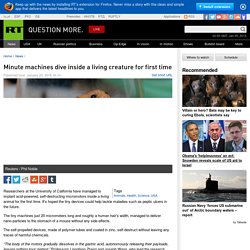
In reference to "This Software Take Us One Step Closer to Biological Nanomachines." This Software Takes Us One Step Closer to Biological Nanomachines. DNA nanobots deliver drugs in living cockroaches: It's a computer – inside a cockroach. Nano-sized entities made of DNA that are able to perform the same kind of logic operations as a silicon-based computer have been introduced into a living animal. (x-po. The five kinds of nanotechnology — Metamodern. Why understanding seems stuck: I count five kinds of nanotechnology, of which only three are called by that name.
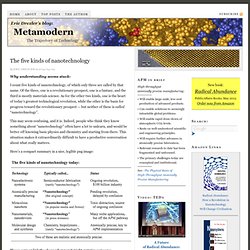
Of the three, one is a revolutionary prospect, one is a fantasy, and the third is mostly materials science. As for the other two kinds, one is the heart of today’s greatest technological revolution, while the other is the basis for progress toward the revolutionary prospect — but neither of these is called “nanotechnology”. This may seem confusing, and it is. How will nanobots change medicine? DNA nanobots deliver drugs in living cockroaches - health - 08 April 2014.
It's a computer – inside a cockroach.

Nano-sized entities made of DNA that are able to perform the same kind of logic operations as a silicon-based computer have been introduced into a living animal. The DNA computers – known as origami robots because they work by folding and unfolding strands of DNA – travel around the insect's body and interact with each other, as well as the insect's cells. When they uncurl, they can dispense drugs carried in their folds.
The Powerful Promise of a Puzzling New Microscopic Combustion Engine. Engines have played a crucial part in the industrialization of the world.

It’s hard to think of an innovation that has had more impact. The trend today is toward smaller, more efficient engines. There are jet engines the size of coffee cups powering autonomous aircraft and powerful electric motors that make children’s helicopters more useful than anything that was possible just 10 years ago. Exploiting Bacteria to Produce "Living Materials" A group of researchers at the Massachusetts Institute of Technology have unveiled a system whereby bacterial cells are engineered in such a way that they incorporate specific non-living materials into their biofilms, creating a "living material".
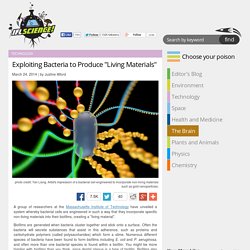
Biofilms are generated when bacteria cluster together and stick onto a surface. Spherical Nucleic Acids (SNAs) Scientists create Terminator-style muscle at 1,000 times human strength. Published time: December 22, 2013 16:46 Edited time: December 24, 2013 08:37 Screenshot from YouTube user Berkeley Lab American scientists have developed a robotic muscle 1,000 times more powerful than a human’s – using a revolutionary material that fluidly changes its properties.
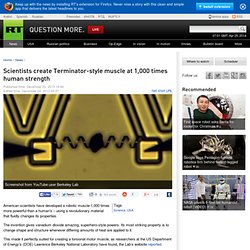
The invention gives vanadium dioxide amazing, superhero-style powers. Its most striking property is to change shape and structure whenever differing amounts of heat are applied to it. This made it perfectly suited for creating a torsional motor muscle, as researchers at the US Department of Energy’s (DOE) Lawrence Berkeley National Laboratory have found, the Lab’s website reported. Added to this is the material’s capacity for changing size and other physical characteristics. Scientists Use a Mutated Virus to Build a Better Battery. Oxford University develops nanotrains. The University of Oxford and the University of Warwick have developed DNA-controlled micro transport networks that are capable of self assembly and disassembly if required.

The system was inspired by melanophores, the subunit within fish cells that controls their pigments and can allow them to change colour. Tracks in the network, which span tens of micrometers in length, all come from a central hub in a pattern the researchers behind the technology have likened to the spokes of a bicycle wheel. DNA is an excellent building block for constructing synthetic molecular systems, as we can program it to do whatever we need. We design the chemical structures of the DNA strands to control how they interact with each other. Using Fluorescence Lifetime Imaging Microscopy to Monitor Theranostic Nanoparticle Uptake and Intracellular Doxorubicin Release - ACS Nano. Johan S.
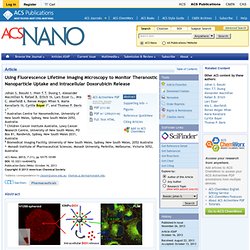
Basuki †, Hien T.T. Duong †, Alexander Macmillan §, Rafael B. Erlich †‡, Lars Esser † , Mia C. New nanoparticle delivers, tracks cancer drugs. Chemical engineers and clinicians from UNSW and Monash University have synthesised a new iron oxide nanoparticle that delivers cancer drugs to cells while simultaneously monitoring the drug release in real time.

The result, published online in the journal ACS Nano, represents an important development for the emerging field of theranostics – a term that refers to nanoparticles that can treat and diagnose disease. “Iron oxide nanoparticles that can track drug delivery will provide the possibility to adapt treatments for individual patients,” says Associate Professor Cyrille Boyer from the UNSW School of Chemical Engineering. By understanding how the cancer drug is released and its effect on the cells and surrounding tissue, doctors can adjust doses to achieve the best result.
Simple urine test uses nanotechnology to detect dangerous blood clotting. Life-threatening blood clots can form in anyone who sits on a plane for a long time, is confined to bed while recovering from surgery, or takes certain medications. There is no fast and easy way to diagnose these clots, which often remain undetected until they break free and cause a stroke or heart attack.
However, new technology from MIT may soon change that: A team of engineers has developed a way to detect blood clots using a simple urine test. The noninvasive diagnostic, described in a recent issue of the journal ACS Nano, relies on nanoparticles that detect the presence of thrombin, a key blood-clotting factor. Such a system could be used to monitor patients who are at high risk for blood clots, says Sangeeta Bhatia, senior author of the paper and the John and Dorothy Wilson Professor of Biochemistry. Lead authors of the paper are Kevin Lin, a graduate student in chemical engineering, and Gabriel Kwong, a postdoc in IMES. Accelerator on a chip: Technology could spawn new generations of smaller, less expensive devices for science, medicine. In an advance that could dramatically shrink particle accelerators for science and medicine, researchers used a laser to accelerate electrons at a rate 10 times higher than conventional technology in a nanostructured glass chip smaller than a grain of rice.
The achievement was reported today in Nature by a team including scientists from the U.S. Department of Energy's (DOE) SLAC National Accelerator Laboratory and Stanford University. "We still have a number of challenges before this technology becomes practical for real-world use, but eventually it would substantially reduce the size and cost of future high-energy particle colliders for exploring the world of fundamental particles and forces," said Joel England, the SLAC physicist who led the experiments.
"It could also help enable compact accelerators and X-ray devices for security scanning, medical therapy and imaging, and research in biology and materials science. " A Boy And His Atom: The World's Smallest Movie. 8 Incredible Nanotechnologies that Actually Exist Today. Meet the Milli-Motein, a tiny, reconfigurable robot that could "become almost anything" 5D optical memory in glass could record the last evidence of civilization. Using nanostructured glass, scientists at the University of Southampton have, for the first time, experimentally demonstrated the recording and retrieval processes of five dimensional digital data by femtosecond laser writing.
The storage allows unprecedented parameters including 360 TB/disc data capacity, thermal stability up to 1000°C and practically unlimited lifetime. Coined as the 'Superman' memory crystal, as the glass memory has been compared to the "memory crystals" used in the Superman films, the data is recorded via self-assembled nanostructures created in fused quartz, which is able to store vast quantities of data for over a million years. Merging bioengineering and electronics: Scientists grow artificial tissues with embedded nanoscale sensors. A multi-institutional research team has developed a method for embedding networks of biocompatible nanoscale wires within engineered tissues. These networks—which mark the first time that electronics and tissue have been truly merged in 3D—allow direct tissue sensing and potentially stimulation, a potential boon for development of engineered tissues that incorporate capabilities for monitoring and stimulation, and of devices for screening new drugs.
The researcher team—led by Daniel Kohane, MD, PhD, in the Department of Anesthesia at Boston Children's Hospital; Charles M. Lieber, PhD, at Harvard University; and Robert Langer, ScD, at the Massachusetts Institute of Technology—reported their work online on August 26 in Nature Materials. One of the major challenges in developing bioengineered tissues is creating systems to sense what is going on (e.g., chemically, electrically) within a tissue after it has been grown and/or implanted.
LEGO-like DNA Structures. New chemical circuits make becoming a cyborg even cooler. Secrets of the first practical artificial leaf. A detailed description of development of the first practical artificial leaf -- a milestone in the drive for sustainable energy that mimics the process, photosynthesis, that green plants use to convert water and sunlight into energy -- appears in the ACS journal Accounts of Chemical Research.
The article notes that unlike earlier devices, which used costly ingredients, the new device is made from inexpensive materials and employs low-cost engineering and manufacturing processes. Daniel G. Nocera points out that the artificial leaf responds to the vision of a famous Italian chemist who, in 1912, predicted that scientists one day would uncover the "guarded secret of plants. " The most important of those, Nocera says, is the process that splits water into hydrogen and oxygen. The artificial leaf has a sunlight collector sandwiched between two films that generate oxygen and hydrogen gas. The author acknowledges support from the National Science Foundation and the Chesonis Family Foundation.
3D Printing Droplet Networks. Peter Rothman. Craig Venter: On the verge of creating synthetic life. Scientists observe your body's own self-assembling nanomachines in action. Thanks for linking that, utterly amazing. Isn't it though? How a Supercomputer May Have Finally Unlocked a Way to Beat HIV. This Is a Heat Map of a Single, Living Cell. This new molecule could be guided through your body with a magnet. Brain Preservation Foundation. Chemists Work to Desalt the Ocean for Drinking Water, One Nanoliter at a Time. June 27, 2013 AUSTIN, Texas — A prototype "water chip" developed by researchers at The University of Texas at Austin in collaboration with a startup company. Watch a nanotube being eaten, and then barfed back up, by a flake of iron.